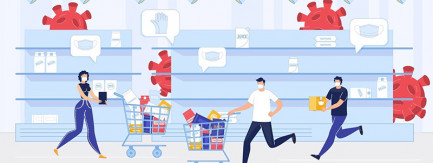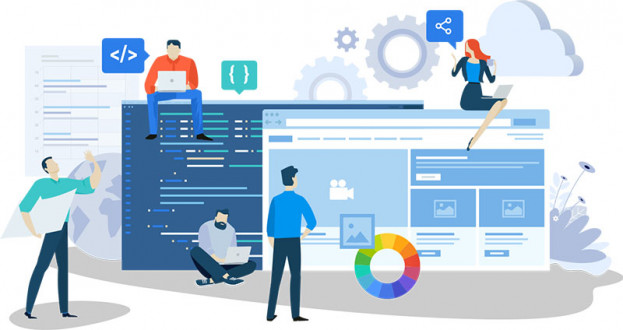The Ultimate Guide To Building Your eCommerce Website
“Almost three-quarters of all Australian households are now shopping online and we expect that around 12% of all consumer spending will be conducted online by 2021. “ ~Christine Holgate - Group CEO & Managing Director Australia Post
- Online trading observations and trends
- Developing an eCommerce strategy
- Platforms - get the right tool for the job
- Building an eCommerce website
- Digital Agency Melbourne team
No doubt 2020 will go down in history as one of the most important shifts in eCommerce consumer behaviour. The implications of COVID-19 shutting down economies, forcing business to close, quarantines and lockdowns have affected all industry sectors in some shape or form - from industrial production to travel, transportation to groceries, schooling to healthcare. Every industry is fighting shock and COVID-19 fatigue while learning to cope and adapt to this new business paradigm.
Trends in online shopping have changed dramatically as we have moved from physical to online shopping channels (KMPG Image).
While we continue to experience the effect of COVID-19 on the economy, businesses who can pivot and change their models will be able to capitalise on the growing online shopping audience with some prudent eCommerce online business remodelling.

2020 eCommerce Observations and Trends
As of January 2019, online shopping is responsible for 9% of Australia’s total retail, with eCommerce Revenue in the Australian market projected to reach AUD$35M in 2020. We can expect these numbers to be much higher due to the increase of online shopping activities because of the COVID-19 pandemic.
From bulk-buying to online shopping, people are changing what, when and how they are buying.
Clear trends are also emerging as to how our online purchasing behaviours have shifted. Evidence will be provided for the more dramatic comparisons when the 2020 statistics are released.
One of the first instances of behaviour changing was directly attributed to panic buying. Humans are truly creatures of habit - we like to stick to our routine and brands, and COVID-19 converted our panic into some very particular buying habits. Panic buying caused Costco and Amazon to run out of household staples (toilet paper, hand sanitiser and tissues) as both lockdown and health warnings emerged. When supplies ran out in traditional brick and mortar outlets, shoppers turned to flood these online shopping outlets.
Men were also found to be shopping online and avoiding in-store experiences more than women. This includes taking advantage of options that limit in-store interactions like BOPIS (buy online, pick-up in-store), curbside pickup and subscription services. Pre-orders are likely to become increasingly popular from a marketing perspective despite the risks involved regarding undelivered products.
While this may not be feasible at a large scale for certain industries, it can prove to be a powerful market research tool.

Six key consumer behaviour thresholds are tied to the COVID-19 pandemic and their results on markets.
“49 per cent say that due to the coronavirus outbreak, they are concerned about receiving apparel or other products that were produced in impacted areas such as China.” (Source)
- Proactive health-minded buying (purchasing preventative health and wellness products).
- Reactive health management (purchasing protective gear like masks and hand sanitisers).
- Pantry preparation (stockpiling groceries and household essentials).
- Quarantine prep (experiencing shortages in stores, making fewer store visits).
- Restricted living (making much fewer shopping trips, limited online fulfilment).
- A new normal (return to daily routines, permanently altered supply chain).
A secondary trend that appeared in 2020 is that 89% of total eCommerce purchases in the country will be domestic. “Shop local” has become a uniting slogan to support our business along with fears of overseas product contamination.
Australian Top 10 eCommerce Stores
As of February 2019, this is the list of Aussies' favourite online retailers. These sites were chosen based on traffic, user experience and customer satisfaction ratings:
While Amazon (and Amazon Prime) have dominated the market in many other countries, Australia is still slow on the uptake until 2020 COVID-19 restrictions were imposed and forced us to convert to online shopping for anything but essentials. They have also converted masses of traffic with their Amazon Prime accounts with media streaming and free delivery.
Do you need to reconsider your eCommerce strategies? The proof is in the statistics.
“24% of Boomers and 34% of GenX said they were letting current events impact what items they purchase, compared to nearly half of Millennials.” (Source)
One survey of U.S. and U.K. consumers found that 96% of Millenials and Gen Zs are concerned about the pandemic and its effects on the economy. This concern is leading them to change their behaviour more dramatically than other generations, which includes cutting back on spending, stocking up on items and spending less on experiences.
In response to this, consider adapting marketing strategies for better Conversion Rate Optimisation, User experience and maximising social media platforms and channels.
”GenZ and Millenials are most likely to make a purchase influenced by social media." (Source)
“1 in 4 companies are selling items via Facebook and online shoppers think that social media platforms benefit their purchasing decisions.”
Online retailers that have at least one active social media account make 32% more sales than online retailers that don’t use social media platforms. (Source)
Should your business shift its eCommerce model?
COVID-19 has necessarily facilitated the faster adoption of online shopping behaviour. Australians have been slow on the eCommerce uptake compared to other countries. Products and varieties that are available worldwide are less readily available to the Australian shopping markets due to tariffs, high costs in shipping and extensive wait times from China, Europe or North America.
Aspects that have supported uptake in eCommerce building include:
Trust building
Companies like eBay and Amazon Prime are acquiring more shoppers by building their value chain and making it incredibly easy to try out their service and make life easier for customers. Offering prime video content bundled with shipping, they get to build shipping models based on economies of scale, drown out their competitors and encourage easy shopping with home voice aid models like Alexa.
Shop local messaging
As travel restrictions have been put into place and lockdowns continue, people are being forced to shop locally. In addition, support for local businesses has flourished with the awareness around Food Delivery companies, choosing to eschew gig players like UberEats and Deliveroo by calling directly and supporting local businesses and their bottom lines.

The eCommerce businesses pivot
Many businesses have managed to completely pivot their services and models in the wake of closures. Small businesses that have been agile enough to think outside the box and continue with adjusted services have managed to thread out a living and even thrive in the anticipation of the shopping behavioural changes. Contactless, delivery and pickup services increased the safety measures and protocol, thus capturing a niche, temporary and pop-up style market. Those that continue to evolve to the changed and perhaps even permanent adjustments to behaviour will be able to survive and even thrive.
Bricks and mortar stores have been forced online and smaller cottage industry businesses have been able to build a customer base with social media, forcing adaptation and innovation. The ease of platforms such as Shopify and Wix have even the smallest businesses viable online in even a few short hours.
Convenience Categories
Easy living products such as Freshly meal plans, weekly meal ordering, aggregate producers and DIY products have filled some of the creative endeavours of those stuck at home. Home and gardening DIY, cooking and meal planning and online courses have filled the extra hours that would normally be socialising and filled with endless tasks.
Consumer sentiment shows they are more willing to move away from trusted big brands because of less availability (panic buying led both Costco and Amazon to completely run out of toilet paper) and allow smaller businesses the opportunity to fill the gap. Emerging companies have capitalised on this sentiment.

Platform UX
Many eCommerce platforms make it much easier and faster to shop. With regular list building, recommendations and ease of ordering and delivery, the UX is complete. Companies are modifying their APPS, platforms and messaging on the fly to adjust to consumer behaviour shifts, instilling confidence in the consumer that they and their buying experience are still top of mind.
Knowing your user’s change and shifts in behaviour and usage are more important than ever. Being able to reach them on the platform they are engaged on and optimising your omnichannel marketing to attract, engage, delight, and ultimately convert(click article)
Every business needs to keep on top of both its branding and messaging along with product security and UX. Now is the time to do a deep dive review of your UX and conversion process as your user engagement could be changing daily and weekly. In normal times, the average shopping cart abandonment rate is around 68.8% and are affected by:
- Shipping costs
- Forced account making
- Long & complicated checkout
- Inaccurate calculated costs upfront
- Excessive delivery times
- Untrustworthy site
- Website errors & crashing
- Slow site speed/experience
This all adds to your User Experience (UX) Design. Savvy online shoppers have a very low tolerance for an experience that isn’t easy, fast and reliable. Many large online retailers experienced this for the first time with panic buying, and sites shutting their down due to the inability to keep up with delivery requests. Most resolved this quickly, but some have suffered permanent reputation damage and lost customers as a result.
“It was really frustrating to spend the time selecting things I want, just to find out they were out of stock.”
~Marie, 38, WA

AI Trends in eCommerce
AI has no doubt contributed many things to society in general, but there are a few things, in particular, we’ve noted that have amplified eCommerce shopping:
- Portable card readers (RFID and stock tracking, payment readers - (Square, Stripe, PayPal).
- The sophistication of suggest/recommend algorithms from shopping websites to Google Network Advertising to relevance in Search and Display paired with smart devices.
- Smart devices (Amazon Echo and Alexa, Google Siri and Nest) and searches.
- IoT (Internet of Things) ubiquity pairing an infinite amount of data and delivery methods means connected devices are now able to transact and function at unimaginable speeds autonomously to track, deliver, and disrupt the traditional chain supply management and transportation systems.
The Buy-Now-Pay-Later Shift
"87% of consumers between the ages of 22 and 44 have expressed interest in BNPL."
Statistics show that Millennials are choosing not to use credit cards anymore. Distrust from previous generational debt and experience paired with lower wages and financial insecurity is forcing a shorter-term view of cash handling.
AfterpPay Co-founder Nick Molnar says customers use his service for primarily high-money buys — the average purchase through AfterPay is over $100. (source)
ECommerce - Get the right tool for the job
ECommerce platforms
When it comes to choosing your eCommerce platform- size does matter. Of the plethora of platforms and product methodologies, there are multiple ways to get to the endpoint.
You’ll need to consider TCO (total cost of ownership) in each of these cases to make a decision. Factors include initial implementation (consulting, development) to ongoing expenses, and many recurring costs like licensing, hosting, support retainers, and more.
Let's take a look at the 3 platform types:

SaaS - Service as a Software - access web-enabled platform. One monthly fee, easy setup, low start-up costs, no maintenance - they host everything, but you are beholden to their platform options and products (such as themes).

IaaS - Infrastructure as a Service - Cloud-based hardware and software for database, storage and networking. You install databases, payment processing and manage every step of the process from payments to updates. They provide infrastructure to host and scale. You’d need to have a dedicated developer for this, upgrades and maintenance but no infrastructure is required.

PaaS - Platform as a Service - Install your environment and software. Great for sandbox, and enterprise-level business. They can be very expensive you still must maintain the environment. Great for faster testing, creativity and implementation. Custom APIs can be difficult, compatible, cloud computing and can take a very long time.
Multi-sided or reseller SaaS platforms (aggregates) include the likes of giants like EBay, Amazon and Zappos. They are massively scaled platforms that connect sellers with used Huge - easy to set up. Instant traffic, guaranteed payment, low shipping. Their tariff allows for low operating costs and higher return percentages. They are more about the amount of control from products to shipping to payment.
Shopify, Wix, PrestaShop, Weebly - Online store builders. They will host your store and small website - everything is included, they are super easy for the DIY to set up. You control shipping modules and every aspect including traffic. Requires no web building experience or coding. Themes and templates are quick to set up, and you can choose your payment method. Monthly fees are standard but predictable. There is no cost for setting up. Use platform domains or pay extra for your premium personal domain. The benefits is customisation, integrations and APIs.
Designed for WordPress and other free CMS platforms, these are mainly open source and free but it's a steep learning curve for most. Generally requires a web developer, and you will pay for hosting, domain registration, etc. Benefits include a vast array of plugins, and an endlessly customisable website themes and design. Integrations have been designed for most major eCommerce APIS, Best SEO available.
Enterprise Level Magento, SAP, Salesforce, Oracle, IBM
Benefits are full customisation, flexibility and scalability, powerful custom development, testing and implementation. Disadvantages include sandbox and API's can be time-consuming to develop, are very expensive, compare buying vs renting infrastructure, and dependence on owned vs operated platforms.
Research Tools
These tools will provide detailed analysis about your competitors, identify opportunities in your niche, and can signal how to improve your site and campaigns.
- SEMRush - This is hands down the most comprehensive tool for keyword, SEO, organic, PPC and competitive analysis. You can build your website project and monitor thousands of inputs, data and rankings. It's a highly advanced tool for small businesses, but perfect for larger organisations who want to track their rankings in detail.
- Survey Monkey - Find out more about your users with this freemium model tool.
- Google Keyword Planner- Research your keywords, traffic volumes as you building your organic and paid search keywords.
Business Tools
Manage your organisations' day-to-day operations, logistics and finances of your eCommerce store.
- Asana - Project management.
- Trello - A visual tools for keeping track of tasks lists and dates.
- Oberlo - Drop-shipping modules.
- Xero - Integrated accounting, invoicing and reporting.
- Veequo - Multi-platform inventory management.
- Square, Stripe, PayPal - Payment APIs.
Marketing Tools
Your messaging should change to reflect current trends in marketing. It should provide the answer that people want to know about. Your brand story is a powerful tool that can be used to leverage customers, employees and stakeholders. Read more about writing a great brand story.
Here are some platforms you can use to let the world know you exist, drive traffic, convert leads into customers, and build your brand.
- Hubspot (inbound article link) for drip and direct emails, automated marketing processes, lead funnels, branded landing pages, signups. It has a huge list of integrations as well. Best on the block as a stand-alone CRM.
- Facebook & Instagram Ads, Social content.
- Mailchimp - for easy to use FREE email marketing with great template builder and design options.
- ClickFunnels - Build you lead generation funnels on this visual workflow tool including a CRM, landing pages and payment gateways.
- Google Search, Display, & Shopping, YouTube.
- Buzzstream - A tool for outreach, link building, influencers and a heap of other Digital PR tools.
Analytics Tools
To tell you how well everything you’re doing is working and spot any leaks in your sales funnels
- Google Analytics, Google Search Console, and Google Ads all connected for the most integrated analytics experience you can get.
- Adobe Analytics - Mix, match and analyse data from anywhere in the customer journey. Versatile reporting, predictive intelligence and more.
Design Tools
- Canva - Simply awesome free graphics program with thousands of template and ideas for all your marketing needs.
- Adobe InDesign, Photoshop & Illustrator - The undoubted industry leader in graphic, document and image design.
- Fiverr - Outsource all of your design needs, fast, cheap, quick.
- Shutterstock, Istockphotos, Pexels - For all your free and paid video, photo and graphic stock needs.
- Google Fonts - Free, easy to install and guaranteed compatibility.
- Envato - Digital assets and services from sound and video clips, to the world's best themes, CSS, and coding elements.
CRO (Conversion Rate Optimisation) Tools
Ensuring that your customers have the optimal journey that results in your goal (sales) is paramount in eCommerce. Cart abandonment was addressed above, and here are some tools that will help address roadblocks, objections, and suboptimal performing pages.
- Hotjar - A tool that visualises your customer journey throughout your pages identifying hotspots, videoing customer journeys, funnel tracking and exit surveys.
- Google Analytics - using Behaviour reports and flow, and Goals, you can glean vast amounts of information through page drop off rates, and lost conversions.
- Survey Monkey - This is a great freemium tool you can use Embedded Surveys, Popup Invitations, and Popup Survey so you can start collecting feedback right away.
- Clickfunnels - This platform will help you convert your website visitors into leads follow-up with your visitors, even after they leave your page.

Steps To Building a Website
You’ve done your work creating an idea/proof of concept. Or maybe your business needs to revise its current website, and scale the current model, or build in additional functionality.
Here are the steps your website planning journey will need to consider
Read more about determining what kind of website you'll need here.
1. IA (Information architecture) or sitemap layout
Completing your sitemap is essential to understanding and organizing your customers' journey. You need to be able to justify every page and how content. Never Going two clicks beyond the home page is the best practice. If you have further pages that means you need to consider reorganising your content layout and aggregation. Using search tools, product categories, tags and blog pages will help you separate the main website's purpose (sales) into well-defined areas of information and Calls-To-Action.Consider your Navigation elements (top menu and styles, footer menu) and search tools. If your site is too large, you have multiple locations or businesses within one, or you need to provide user login functionality, consider using a subdomain to organise your site.
2. Collate your website design & content including
- Brand assets including hero images, product images, logos, graphic elements.
- Design elements including picking a prebuilt theme and modifications including brand colours, fonts, graphics for your website.
- Page content including layout and content blocks, copy, modules, Call-to-action areas, keywords and metadata.
- Media including videos, social media elements and links.
3. Build the wireframes
This is when the page modules and functional structure of your website are created:
- Assembling your page and sitemaps with navigation links.
- Basic design elements that include page layouts and content blocks and modules.
- Functionality elements include your eCommerce module or platform, API’s and integrations, payment gateways, web apps and customer journey conversion modules.
4. Conversion rate optimisation
- By clearly defining the customer journey and end goal. Ensuring all obstacles are dealt with that could cause abandonment.
- Concise Call to Actions (CTA’s) for specific actions or directions along the journey.
- Ensure mobile versions and speed are optimised.
- Automate as many processes as possible.
5. Website launch
- QA - Checking for missing content, spelling and errors.
- Testing all functionality, from search to goal completion.
- Handover to the client. Education session and support period.
6. Digital marketing
- Consider a review of your current PPC campaigns with Google Search, Display, Youtube and consider new options for targeted remarketing.
- Review and assessment of your businesses paid, earned and owned social media content.
- Consider Influence marketing (Insta, Snapchat, Youtube) in you have a decent following.
- Plan your content marketing strategy on Facebook, LinkedIn, Insta, Twitter, Youtube, email and website.
- Hatch your organic SEM (Search Engine Marketing) content, pillar pages and blogs.
- Ensure all metadata is being optimised on all new and revised content.
- Try using lead funnels strategies using webinars, lead magnets, sign-ups, newsletters and freemium SaaS models.
- Ensuring you have set up Using Google My Business (Google Maps - article), and encouraging Knowledge Graph with schema markup and snippets.
- Continually asking for reviews, recommendations, referrals.
- Use automated marketing sequences to drip feed your leads, potentials and customers (Hubspot is our tool of choice).
7. Designing your customer support and after-care
- Developing Return, complaint policies and procedures.
- Adding value after they have purchased to gain loyalty, trust and encourage advocacy through a newsletter, offers, additional knowledge, ideas and tutorials.
- Ensure your web-managed services include hosting, domain registration, and support.
8. SEO - Search engine optimisation
- Focus on your organic search strategies with content and metadata with this article.
- Perform regular reporting and competitive analysis for SERP (Search Engine Results Page), Google My Business, keyword performance, and organic content on your website.
- Continuous upgrade of website content, internal and external website linking, and back-linking efforts.
9. Measurement & Analytics
- Connecting your Google Analytics, Google Ads and Search Console. This combination of measurements can give you a solid indication of CRO issues through traffic, acquisition, channels, goals and conversions.
- Benchmarking results and regular reporting will give you the optimal understanding in performance and the success in building you're Commerce business.
10. Security and Web Services
- The integrity of your data and website is of paramount importance. Secure hosting, firewalls, backups, 2-factor authentication are absolutely non-negotiable in preventing hacking, DDOS attack, data corruption and loss. So many of these issues can be very easily managed by your web host. (Read more about website security)
- Domain registration, hosting, email, and technical support is something you might just take fror granted in your web-managed services. Having the security of 24-hour support should your site go down or get hacked. Consider the most secure option when choosing your web managed services.
Conclusion
As you are assessing your current and future eCommerce business needs, consider the many changes the many changes and trends in the eCommerce sector. New habits and behaviours that are here to stay that your business can capitalise on - online shopping and work from home behaviours that are now ingrained in our daily lives. Build on the knowledge, adapt, and anticipate the next steps in eCommerce evolution. Keeping your online business on top of these is how your eCommerce will continue down the path of success.
At Click Creative Digital Agency, our sole purpose is to make sure you have all the tools for your business to thrive. Get in touch with us today to talk about how we can guarantee your success.
